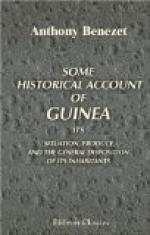[Footnote A: John Barbot’s description of Guinea, page 154.]
[Footnote B: Astley’s collect. vol. 2. page 535.]
In the Collection[A] it is said, “That the fishing business is esteemed on the Gold Coast next to trading; that those who profess it are more numerous than those of other employments. That the greatest number of these are at Kommendo, Mina, and Kormantin. From each of which places, there go out every morning, (Tuesday excepted, which is the Fetish day, or day of rest) five, six, and sometimes eight hundred canoes, from thirteen to fourteen feet long, which spread themselves two leagues at sea, each fisherman carrying in his canoe a sword, with bread, water, and a little fire on a large stone to roast fish. Thus they labour till noon, when the sea breeze blowing fresh, they return on the shore, generally laden with fish; a quantity of which the inland inhabitants come down to buy, which they sell again at the country markets.”
[Footnote A: Collection, vol. 2, page 640.]
William Smith says,[A] “The country about Acra, where the English and Dutch have each a strong fort, is very delightful, and the natives courteous and civil to strangers.” He adds, “That this place seldom fails of an extraordinary good trade from the inland country, especially for slaves, whereof several are supposed to come from very remote parts, because it is not uncommon to find a Malayan or two amongst a parcel of other slaves. The Malaya, people are generally natives of Malacca, in the East Indies, situate several thousand miles from the Gold Coast.” They differ very much from the Guinea Negroes, being of a tawny complexion, with long black hair.
[Footnote A: William Smith, page 145.]
Most parts of the Slave Coasts are represented as equally fertile and pleasant with the Gold Coast. The kingdom of Whidah has been particularly noted by travellers.[A] William Smith and Bosman agree, “That it is one of the most delightful countries in the world. The great number and variety of tall, beautiful, and shady trees, which seem planted in groves, the verdant fields every where cultivated, and no otherwise divided than by those groves, and in some places a small foot-path, together with a great number of villages, contribute to afford the most delightful prospect; the whole country being a fine easy, and almost imperceptible ascent, for the space of forty or fifty miles from the sea. That the farther you go from the sea, the more beautiful and populous the country appears. That the natives were kind and obliging, and so industrious, that no place which was thought fertile, could escape being planted, even within the hedges which inclose their villages. And that the next day after they had reaped, they sowed again.”
[Footnote A: Smith, page 194. Bosman, page 319.]




